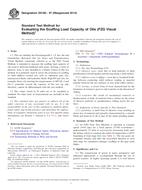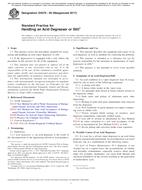1.1 These test methods are applicable to the determination of water-soluble calcium, magnesium, and sodium chlorides used as admixtures in the preparation of graded aggregate road materials.
1.1.1 Method A, Total Chlorides – Add an excess of a standard silver nitrate solution to the filtered sample; back titrate the excess silver with a standard ammonium thiocyanate solution to a red-orange endpoint using Volhard indicator.
1.1.2 Method B, Calcium Chloride – Calcium in an alkaline solution is titrated with standard EDTA solution using calcein modified as an indicator. The color change is from green to blue.
1.1.3 Method C, Magnesium Chloride – Calcium and magnesium, in a solution buffered to a pH of 10, are titrated with standard EDTA solution using eriochrome black T as an indicator. The color change is from red to blue. Magnesium chloride is calculated by subtracting the EDTA calcium equivalent volume determined in the analysis for calcium chloride from the total EDTA volume used, to obtain the magnesium EDTA equivalent by difference.
1.1.4 Method D, Alkali Chloride – Alkali chlorides are calculated from the difference of the total chloride and calcium and magnesium determinations.
Note 1 – These test methods assume that the aggregate did not contain significant amounts of the water-soluble chlorides in question before the admixture was added. If significant amounts of these chlorides are known or suspected to be present, the aggregate shall be tested for these constituents according to these test methods and the proper corrections made.
1.2 All observed and calculated values shall conform to the guidelines for significant digits and rounding established in Practice D 6026.
1.2.1 The method used to specify how data are collected, calculated, or recorded in this standard is not directly related to the accuracy to which the data can be applied in design or other uses, or both. How one applies the results obtained using this standard is beyond its scope.
1.3 This standard does not purport to address all of the safety concerns, if any, associated with its use. It is the responsibility of the user of this standard to establish appropriate safety and health practices and determine the applicability of regulatory limitations prior to use.
1.4 This practice offers a set of instructions for performing one or more specific operations. This document cannot replace education or experience and should be used in conjunction with professional judgment. Not all aspects of this practice may be applicable in all circumstances. This ASTM standard is not intended to represent or replace the standard of care by which the adequacy of a given professional service must be judged, nor should this document be applied without consideration of a project's many unique aspects. The word “Standard“ in the title of this document means only that the document has been approved through the ASTM consensus process.
1.5 The text of this standard references notes and footnotes which provide explanatory material. These notes and footnotes (excluding those in tables and figures) shall not be considered as requirements of the standard.
Product Details
- Published:
- 06/01/2009
- Number of Pages:
- 4
- File Size:
- 1 file , 85 KB
- Redline File Size:
- 2 files , 160 KB


